In Stackfield, users can adjust their availability status and add an out-of-office message, for example during lunch breaks, meetings, or vacation periods. This makes it immediately clear to everyone whether a person is available and how quickly they are likely to respond to requests. Availability status, status messages, and descriptions are visible to all roles.
(Automatic) default statuses
The default statuses are Available (= "Online", solid green dot) and Offline (solid gray dot). These appear at the bottom right of a user’s profile picture or initials, without any additional status message or description, and are set automatically. As soon as a user logs in to Stackfield, their status is set to "Available".
The offline status is displayed as follows:
- Mobile App: Users appear as "Offline" once they close or leave the app.
- Browser: In the browser, users switch to "Offline" by clicking on "Close" (X symbol in the upper right corner).
- Desktop App: By clicking on "Close" in the desktop app (X symbol in the upper right corner), Stackfield will continue to run in the background as the program is only minimized. (The program remains visible in the taskbar and can be accessed by clicking the "up"-arrow in the bottom-right corner.) The status only changes to "Offline" when the program is fully closed (Alt + F4 or via "File" → "Exit" in the navigation bar), when the user logs out, or when the computer is shut down.
Open individual status settings and selection
In addition to the automatically assigned statuses, each user can manually adjust their own status. To open the status settings, click on your name or profile picture at the bottom left of the sidebar. In the dropdown menu "Personal Settings" your name and current status are displayed at the top of the list. By clicking "My Status", the status settings ("What is your status?") will open, where you can make the following adjustments:
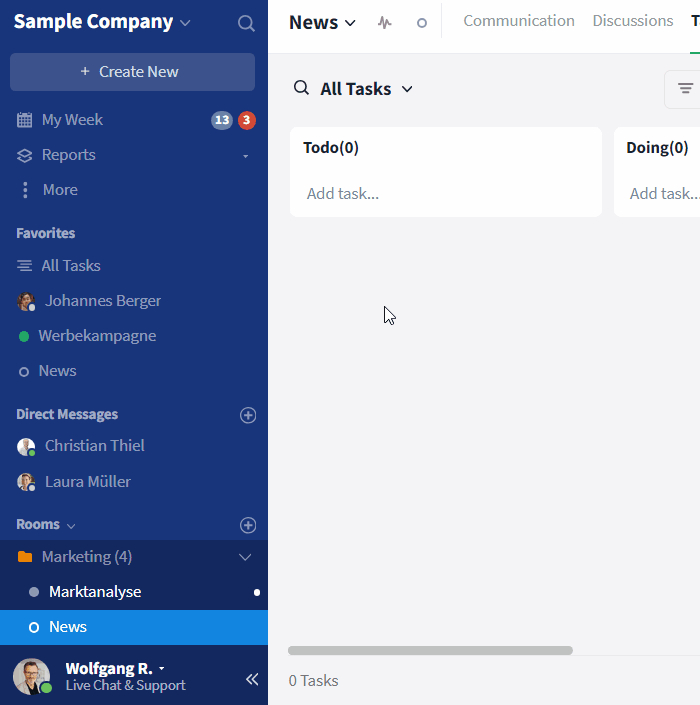
Open status settings
Adjust availability
In the first dropdown menu (default display: "Available"), there are four different status options that indicate whether a person is currently active on Stackfield. The selected status is shown as a small colored dot on the profile picture. Hovering over this dot reveals the status label (e. g., "Absent"). The status is visible to all users within the respective Stackfield organization, for example through the user profile. (See: Practical examples).
 Available:
Available: The user is online and reachable. This status is set automatically after login (unless configured differently for the organization; see
"Note") and when
resetting the status.
 Busy:
Busy: The user is online but occupied, for example in a meeting.
 Absent:
Absent: The user is unavailable for a longer period, for example on vacation. This status remains visible even when the user is logged out.
 Offline:
Offline: The user is currently not active on Stackfield or chooses not to appear as active ("invisible" mode).
Status message and status description (note, duration, replacement, etc.)
A status message can be set in addition to the availability status using the second dropdown menu (default display: "No status message"). In most cases, status messages are displayed next to the user’s name in the form of an emoji. The following status messages are available:
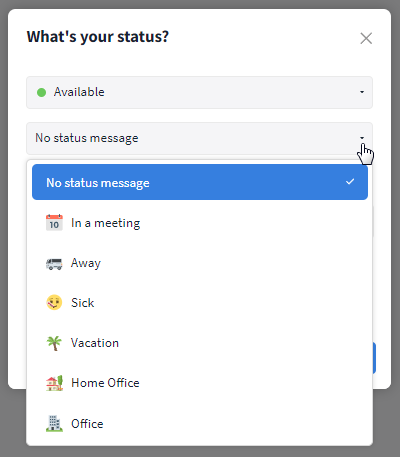
All available status messages
When a status is selected, a text field for an additional status description appears below. Here, you can enter further information, for example, when a vacation ends or who will cover responsibilities during that time. The status description is displayed when hovering over the corresponding emoji and is visible to all members of the organization. (For details, see: Practical examples)
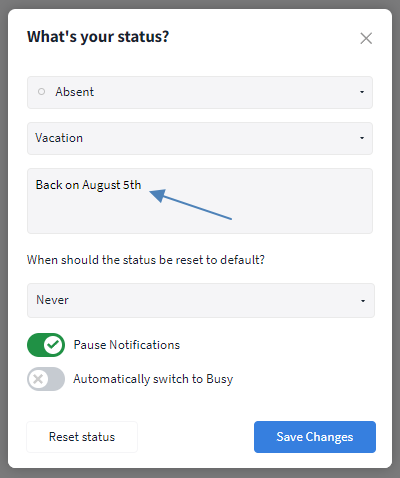
Relevant information can be stored in the status description.
Note: Status messages and descriptions are visible to other users even if you are not logged in to Stackfield.
Pause / enable notifications
In addition to setting a status, it’s also possible to pause all external notifications, including desktop, mobile app, and email notifications, by enabling the "Pause Notifications" option. Notifications will only be reactivated when this toggle is switched off, the status is reset, or the "Activate Notifications" option is selected in the personal settings. When notifications are paused, this is indicated by a small "z" next to the status dot (availability) on the user’s profile picture.
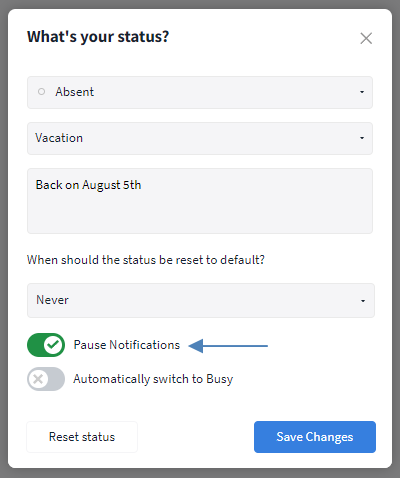
Pause notifications
Note: If the availability status is set to "Busy," notifications are automatically paused. If needed, the toggle can be manually switched off so that notifications remain active.
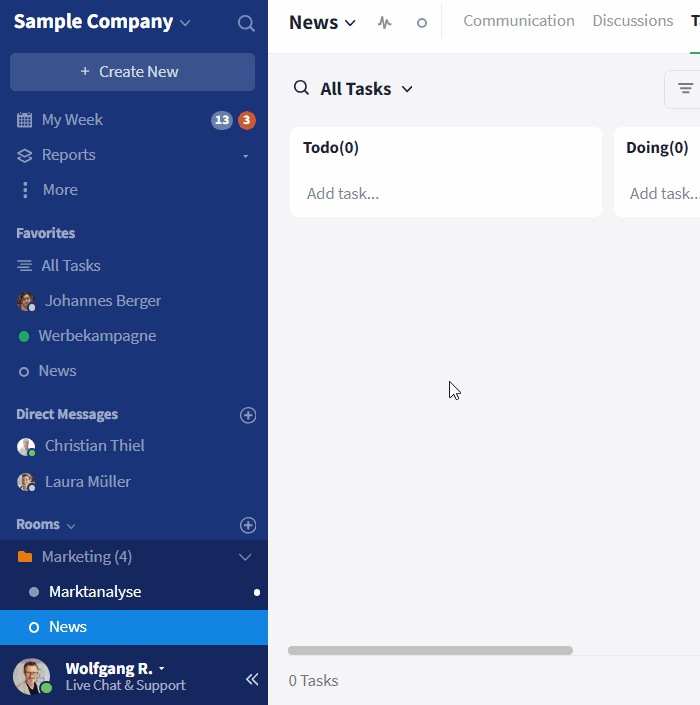
Automatic pausing for "Busy" status and "Activate Notifications"
Automatically switch to Busy
With the feature "Automatically switch to Busy", the user’s status is automatically updated as soon as an audio or video call is started.
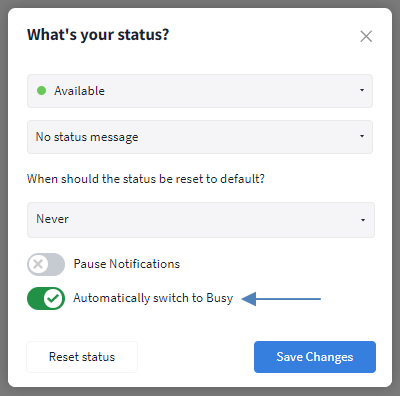
Automatically switch to "Busy"
For this feature to work, the user’s status must be set to "Available" before the call begins. During the call, the status automatically changes to "Busy", and the message "In a meeting" is displayed. After the call ends, the original status is automatically restored.

Example of the automatic status display
Reset the status or edit / delete
The (automatic) default statuses apply without any user interaction. Individual status settings remain active until they are either manually changed or automatically reset after a defined period of time.
The status is not automatically reset by logging in or out. This also applies to the "Offline" status: if a user manually sets their status to "Offline", then logs out and back in again, they will still appear as "Offline" and must manually change their status.
To reset the status manually, open the status settings and select "Reset status". The status will then automatically change to "Available". You can also modify the status at any time by adjusting the various settings options.
Alternatively, the status can be reset automatically after a defined period of time. To do this, open the dropdown menu under "When should the status be reset to default?" and choose either a time period (e. g., "4 hours") or a specific date and time. For example, if a user selects "4 hours", the status will automatically revert to "Available" after 4 hours. The status message will be cleared, and the "Pause Notifications" and "Automatically switch to Busy" settings will be reset as well.
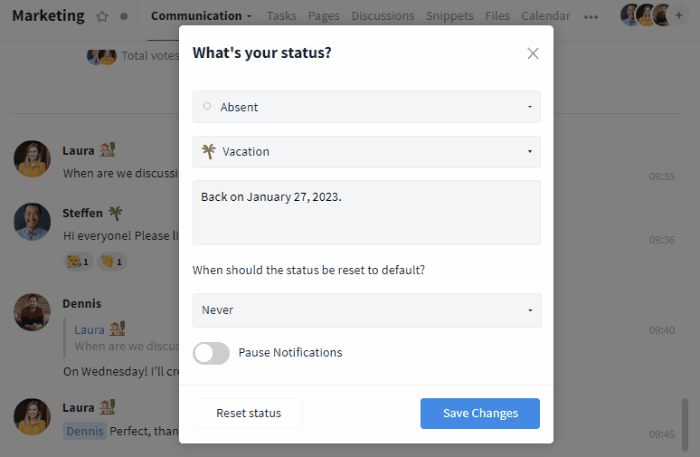
Schedule a status reset at a specific time
Note: If the "Automatically switch to Busy" option is enabled, the system will restore a previously changed manual status automatically after a call (see "Automatically switch to Busy").
Practical examples: Where can I view the status?
The availability status, as well as status messages and descriptions, are displayed across different modules and areas as follows:/p>
Tip: If your company doesn’t currently use a separate tool for leave management, this can also be organized in Stackfield through a dedicated room. Different statuses (and messages) can then be taken into account during planning.
In the communication area
In the Communication module and in Direct Messages, the status message is displayed right next to the user’s name. For @-mentions and questions / answers, the status message appears in the communication stream as soon as the message is sent. Within the communication stream in a room and in the group chat, a member list can be opened by clicking the profile pictures in the top right of the navigation bar. This list shows all users along with their status messages.
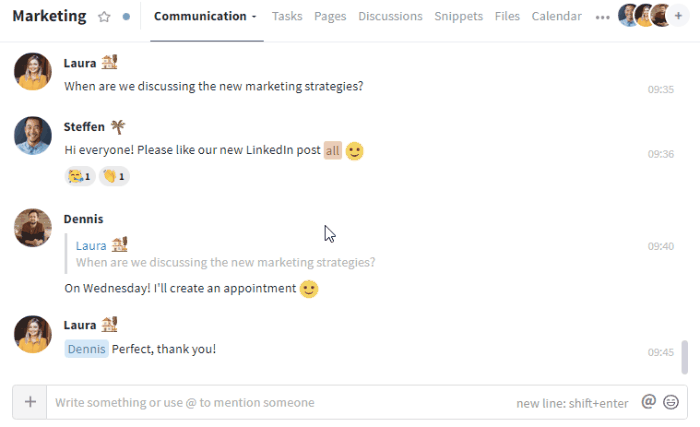
Status message / description in the communication stream
In private chat, the profile picture with the availability status is displayed in the top-right navigation bar. Clicking on it opens the profile, where the status message and description can also be viewed (via mouseover). Starting with the Premium plan, additional user profile information is also available here.
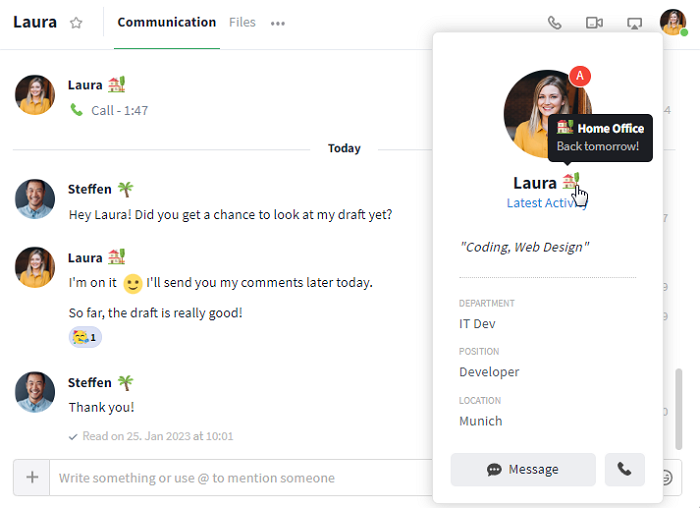
Display in the private chat
In the sidebar, the availability status is shown on the user’s profile picture, and the status message is displayed next to their name.
The status description becomes visible when hovering over the status message.
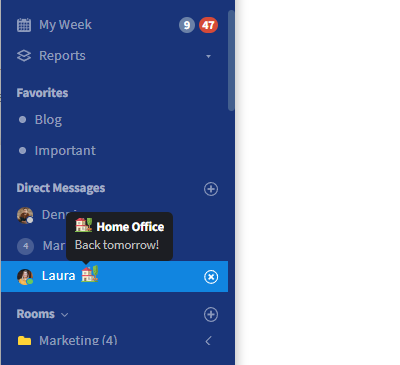
Status message / description in the direct messages
In the comment section of individual modules (e. g., the Pages module), the status message appears directly next to the name of the comment author, and the status description is displayed by mouseover.
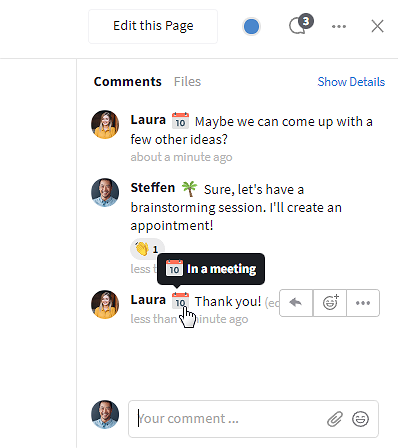
Display in the comment section of the pages module
When making calls (1:1 and conference)
Before or during a call, you can view a person’s status, including their status message and description. This makes it easy to check whether the person you want to reach is currently available. Depending on the chosen communication channel, this information can be accessed via member lists or profiles, for example within a scheduled meeting or chat.
As soon as a call is received or initiated, the profile information, including the status, can be opened directly from the profile picture in the call window.
In conferences, this is also possible either directly through the call window or via the associated conference chat.
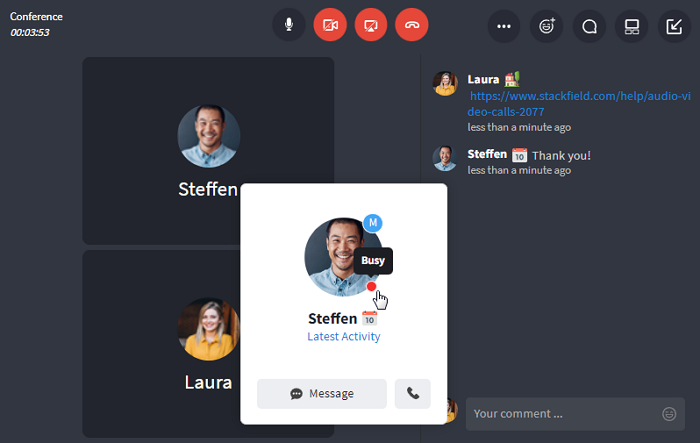
Viewing status information in the conference chat
During (sub)task planning / assignment
In the Tasks module, the status message and description of a user can be viewed when assigning a task or subtask. Clicking the plus icon opens a dropdown list showing all users along with their current status messages. (See also: My Week)
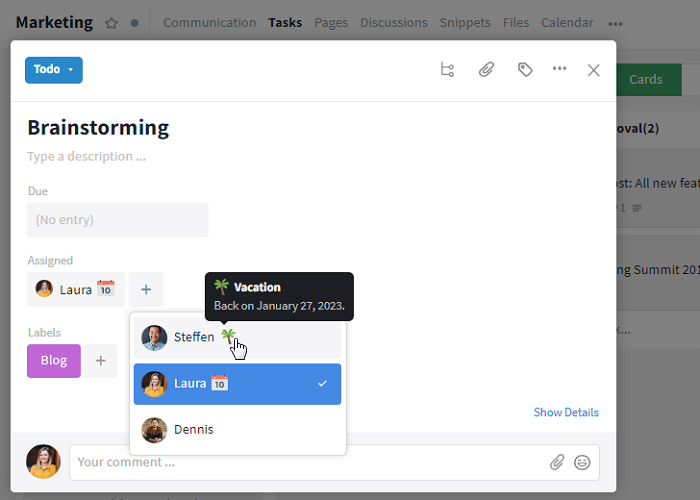
Status message / description when creating tasks
When scheduling events
In the Calendar module, status messages and descriptions can be viewed when adding users to an appointment through the member list that appears during event creation. The same applies when checking availability. (See also: Telephony and My Week)
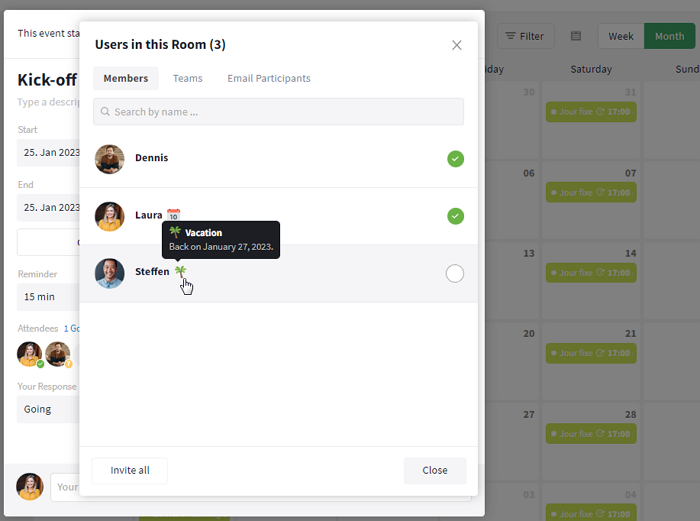
Status message / description when creating an appointment
In My Week
In the overview My Week, status messages and descriptions always appear next to a person’s name. They are displayed either in the dropdown list of the employee management section or directly within the events of the respective day. For example, next to the name of the creator of a task, appointment, or confirmation.
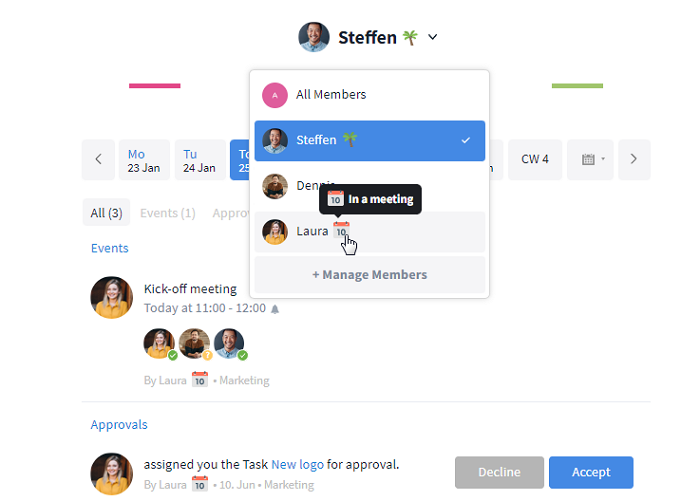
Status message / description in My Week
In the user / room management
Status messages and descriptions of individual users can also be viewed in the member lists within the Members tab of the room settings or organization settings. By clicking on a user’s profile picture, their availability status is also displayed.
For example, if someone is currently on vacation, this can be seen in the room member list through their status (e. g., "Absent" with a date). If needed, a substitute can then be added to the room.
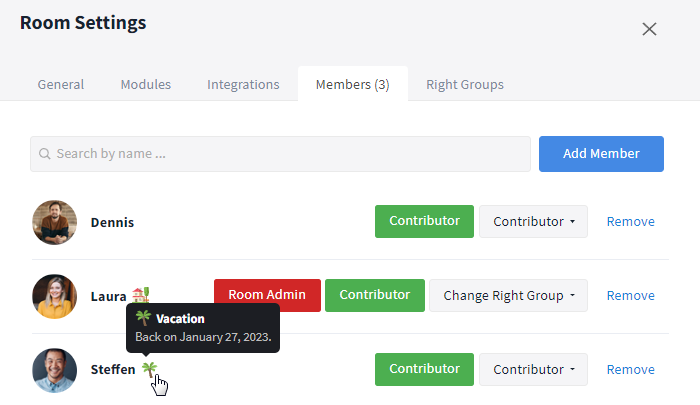
Status message / description in the room settings